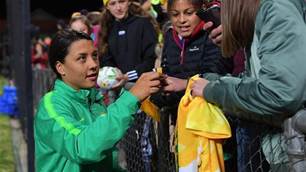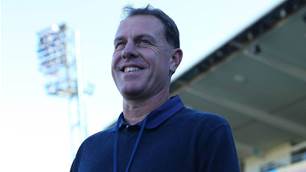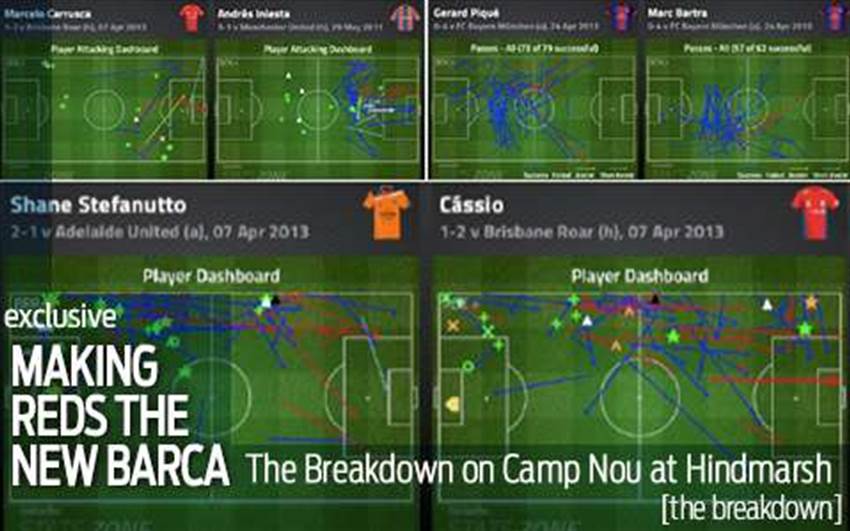JOSEP Gombau seems constantly at pains to emphasise his mission at Adelaide United.
"I want to make Adelaide United play one football style,” he said upon arriving for the first time in Australia. ''This style is what I learned. It's the style that I know from Barcelona and that's to play attacking football. A 1-4-3-3 formation and playing this style, trying to keep possession of the ball to try to play beautiful football for the fans, Adelaide United fans.”
It’s an admirable mantra, and something he’s reiterated in practically every press briefing he’s given in his short tenure so far at Adelaide. Obviously, Adelaide’s bold new direction is something he, the board and the players are keen to emphasise, as it signals an interesting change in philosophy at one of the A-League’s historically most tumultuous clubs.
It is also representative of a wider trend across the globe, wherein clubs have taken the approach that if you can’t beat them, copy them. ‘Them’ is of course Barcelona, where Gombau spent six years building his experience as a coach, and the club which has in recent years experienced unprecedented success in winning countless amounts of trophies, thanks to the possession-based style pioneered by Johan Cruyff and perfected by Pep Guardiola.
The references to Gombau as ‘Pep Gombau’ are obviously tongue in cheek and expecting Bruce Djite to play the Lionel Messi role is a fanciful suggestion but there are still lessons to learn from Barca’s style of play. Most importantly is their obsession with possession – their singular aim is to keep the ball, operating on the theory that without it, you cannot score – and without it, the opposition cannot either.
Central to this is playing out from the back. All of the defenders in Barcelona’s academy are constantly reminded of the need to bring the ball out from defence positively, to take risks and try to transition through midfield with short passes along the ground, rather than falling into the temptation of kicking it long towards the striker.
Even against the top sides like Bayern Munich, even when under immense pressure, even if you’re the 21 year old Marc Bartra, and even if they’re 4-0 down, the central defenders constantly play out from the back…

…and Gombau will ask the likes of Anthony Golec, Nigel Boogard and John McKain to try and keep their distribution tidy even when under pressure.
However, the key to Barcelona’s extraordinary possession statistics – they’ve averaged close to 70 percent possession for the season in each of their last four league campaigns – is midfield. Often referred to as the ‘brains’ of a football team, Guardiola was always keen to emphasise the importance of his central playmakers, and often tried to fit in as many midfielders into a single team as possible, once famously, fielding six all at once.
It is unlikely Gombau will go that far, but like Guardiola (and Vilanova, who replaced the latter in 2012, the Adelaide United coach will try to settle on a midfield trio comfortable in working the ball up the pitch through neat triangles, like Xavi, Iniesta and Sergio Busquets do so so superbly for the Spanish giants.
Xavi is a wonderfully underappreciated footballer. His technical ability is second to none, his creativity and vision simply incredible, and what’s striking about his play is that he mixes this incisive playmaking with clever, calm passes to set the tempo of Barcelona’s passing, rarely giving the ball away. There was no greater example of this than in what many proclaim as the high point of Barcelona’s recent dominance – the 2010/11 Champions League final against Manchester United, when Xavi completed an incredible 141 passes – 34more than anyone else. He helped Barcelona dominate possession to the extent he didn’t have to make a single tackle, interception, clearance, or block. United simply didn’t attack enough for him to have to defend.

There isn’t another footballer like Xavi, but Steven Lustica was deployed to similar effect on the right hand side of Brisbane Roar’s midfield trio in the tail end of last season. In fact, Brisbane are a realistic model for Adelaide aspire to, as they set up their midfield in the Barcelona style, with a defensive midfielder anchoring two playmakers. Lustica’s attempted passes and passes received against Western Sydney Wanderers is a good example of the calm, Xavi-esque role that Gombau will presumably deploy him in.

Lustica has cited Gombau’s philosophy as a pivotal factor in his decision to swap Croatia for the City of Churches. “He (Gombau) explained the brand of football he wants to play and that’s exactly the way I like to play football,” Lustica said. “That passing style suits my style and that’s hopefully what I can bring to the team.”
Xavi shares a good relationship with Andres Iniesta, who plays next to him on the left hand side of the central midfield. Iniesta has superb close control and excellent dribbling skills, and often ventures further upfield than Xavi to attempt slightly more ambitious passes – attributes that Marcelo Carrusca can relate to, if not replicate.

Busquets completes the trio, and he has an important role in defensive midfield – he must drop in between the two centre-backs to help facilitate passing moves from deep, and to compensate for the attacking nature of the two midfielders ahead of him.

It is not all about defence, though, and Busquets still got forward to provide the third assist of the 2011 Champions League final – in a neat coincidence, all three midfielders provided the assists for the three goals scored by the front three.
On the basis of pre-season, the defensive midfield position will fall to either Osama Malik or new signing Isaías Sánchez, whose experience in Barcelona’s academy was clearly a key factor in Gombau’s surprise decision to sign both him and Sergio Cirio before the new coach had even seen the existing squad train. Such a pre-emptive signing shows Gombau’s confident they’ll be able to set the standard for the new philosophy, given their pre-existing understanding of the principles, something Director of Football Michael Petrillo corroborated. "It was important that Josep had the ability to bring in players familiar with his philosophy,” he said, “and who can assist in integrating that philosophy on the field."
Pre-season has seen both Malik and Isaías play that deeper role, both frequently dropping into the backline to split the defence and allowing the full-backs to get forward. This suits the attacking nature of Cassio, who is one of the league’s most adventurous defenders and can be relied on to motor up and down the pitch, as can exciting loan signing, Michael Zullo.
Again, Brisbane’s system becomes a pertinent point of reference. Shane Stefanutto is no Dani Alves, but they share a like-minded willingness to get forward, and the former’s combination play with his midfielders is something Adelaide’s full-backs will look to imitate – Cassio might have even picked up a few tips when facing him in last season’s preliminary final.

Drawing comparisons between Barcelona and A-League players indicates the scale of the challenge awaiting Gombau, and there’s no doubt that he knows the job that he has on his hands. Wherever he can turn theory into practice will be one of the most intriguing storylines of the season.
Related Articles

Bayern's plan to fast-track teen star Irankunda into first team squad

The Best Moments: Re-live another record-breaking Matildas night













